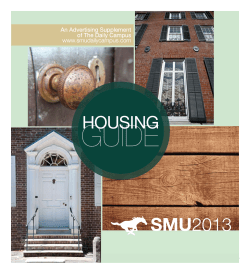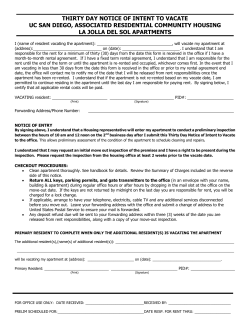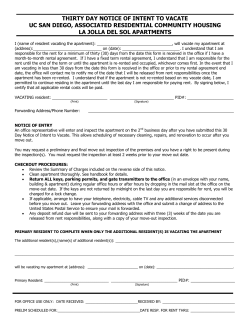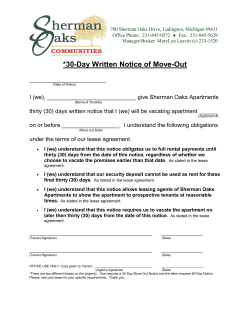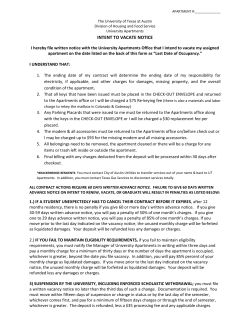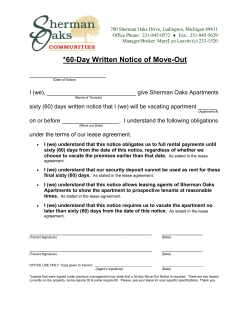
Healthy Home Guide Project for Pride in Living’s
Project for Pride in Living’s Healthy Home Guide Welcome to your new home! PPL’s Healthy Home Guide suggests simple ways you can keep your apartment clean and your family healthy, conserve resources, and save money on your electric and gas bills. Ask your Property Manager if you have questions about anything in this Guide. Three to Note Prevent Water Damage There are times you will need help from PPL to keep your apartment in good repair. If something in your unit, in the building, or in the yard or parking lot of your building is broken, call your Property Manager right away. • Do not leave faucets, tubs or showers running when you are not in the room. • Immediately wipe up any spills! This is true in bathrooms and kitchens, too: even if the floor seems waterproof, it isn’t made to stand up to puddles. Let’s work together to keep your home healthy and looking great! 1 Table of Contents Keeping Your Home Clean and Healthy Housekeeping & Cleaning Trash & Recycling Pest Prevention Clean Air and PPL Smoking Policy Conserving Energy and Water Stop Wasting Energy! Staying Warm in Wintertime Staying Cool in Summertime Conserve Electricity Year-Round Using Appliances Efficiently Managing Water and Moisture Repairs You Can Do How To: Unclog Toilets and Sinks About: Energy-Saving Lightbulbs How To: Basic Maintenance Find Shut-Off Valves • Find the toilet shut-off valves before your toilet is overflowing. They are usually on the wall behind the toilet. 3-8 9 10-11 12 • If the toilet clogs, use a plunger to remove the clog. If the clog remains, call your Property Manager. 13 14 15 16 17-18 19 20 21 22 • If the toilet starts to overflow, shut off the water at the shut-off valve right away. Turn the valve clockwise to shut water off. Keep Drains Clear 2 • If you have grease left over from cooking, pour it into a steel can (such as from canned vegetables) and let it harden. Then throw it away in the trash. • Do not pour grease or oil down the drain. The grease will harden and block the pipe. 3 General Housekeeping Wash dirty dishes every day and wipe kitchen surfaces with a damp cloth. 4 Cleaning Products Try these ideas instead of expensive cleaning products: Taking out the trash and recycling often will keep help keep pests out of your apartment. for: kitchens and bathrooms Mop up spills immediately with a dry towel or rag. Mildew, mold and rot can develop in flooring that stays wet too long. painted walls windows and mirrors If you see strange colors on surfaces (white, orange, green, brown, or black) or smell a musty odor, it might be mold or mildew. Clean with baking soda or borax, or a combination of white vinegar and salt. If the discoloration does not go away or gets worse, tell your Property Manager! Mold can cause serious health problems if it is not addressed. Don’t use metal bristle brushes or other abrasive products when cleaning. They can leave scratch marks. hardwood floors mildew remover toilet bowl cleaner drain cleaner oven cleaner try: baking soda mixed with a little water to make a paste, then rinse with clear water a drop of dish soap in warm water. wash from the bottom of the wall up 1/4 cup white vinegar in 2 quarts warm water. rub window or mirror dry with dishtowel or old newspapers 1 cup white vinegar in 2 gallons warm water. keep mop damp only, not wet. 1 cup vinegar and 1 cup salt paste of borax and white vinegar boiling water baking soda and warm water to make a paste, spread the paste inside the oven and let it sit about 8 hours, then wipe the baking soda out. clean with dish soap and water and rinse with clear water Never mix conventional cleaning products together - some combinations will create toxic gases that are very harmful to breathe. 5 Cleaning Specific Areas Floors • Pick up clutter every day. Keep extension cords and other things out of walking paths. 6 Oven • Clean the oven once a month to prevent grease build-up. Remove oven racks and clean these at the same time. • Avoid using oven cleaner - the fumes are toxic! Try the recipe on page 4 instead. If you must use oven cleaner, turn on the range hood while you are cleaning the oven. • Vacuum carpet weekly. • Sweep and mop hard-surface floors (wood, tile) weekly. Walls & Windows • Clean painted walls gently, using a soft cloth. • Clear clutter off windowsills and dust them at least once a month. • Wash the insides of windows at least once a year. Stovetop • If you have a glass-top stove, clean it with baking soda and water, or dishsoap and water. A razor blade can be used, too: hold it at a 30 degree angle and pull it slowly across the cooktop. Store the razor blade safely out of the way when you’re not using it! • If you have a stove with burner coils and pans, remove them to wash them more easily. Do not immerse burner coils in water! Make sure they are dry before plugging them back in. • Do not use brillo pads when cleaning the oven. This will scratch the finish off the metal. Refrigerator and Freezer • Diluted dish soap works well to clean refrigerators and freezers. Harsh cleansers are not necessary. Rinse everything well with warm water. • Remove trays and drawers carefully. Use a clean sponge or cloth to handwash and dry the inside of the refrigerator. Wash trays and drawers, dry them, and put them back. • Wash around the outside of the refrigerator too, especially around the handles. Dishwasher • If your apartment has a dishwasher, ask your Property Manager if the dishwasher has a filter that needs to be cleaned regularly. 7 Cleaning Specific Areas Range Hood • Wipe dust and grease from the surface of the range hood monthly. • Clean the grease filter on your stove’s range hood when any grease builds up. This should be a part that is easily removed. If you have any questions, ask your Property Manager. Porcelain Plumbing Fixtures (toilets & sinks) 8 Cultured Marble and Fiberglass (sinks, vanities, some shower walls, some bathtubs) • Bathroom sinks and vanities that don’t have a seam are probably cultured marble. • The walls around your bathtub may be cultured marble or fiberglass if they are large panels and look like plastic. • Bathtubs are sometimes made of fiberglass, which is usually warmer to the touch than cast iron. • Toilets and bathtubs almost always have porcelain surfaces, and often bathroom sinks too. • Use a liquid cleanser or diluted dish soap and a soft cloth. Vinegar works well to remove soap scum or rust stains. • Use baking soda mixed with a little water to clean, then rinse well. • Never use an abrasive cleanser, scouring pads or brushes on cultured marble. It scratches easily. • Clean the toilet bowl with a brush. Use a toilet cleaner or try the recipe on page 4. Stainless Steel Plumbing Fixtures (sinks) • Stainless steel plumbing fixtures are shiny metal. Kitchen sinks are usually stainless steel. • Clean stainless steel by scrubbing with a kitchen sponge and a powdered cleanser (baking soda or Bon Ami cleanser) then rinse well. Vinyl Tile and Porcelain or Ceramic Tile (some bathroom floors, some shower walls) • Use a soft cloth and a mild cleanser when cleaning tile. Harsh cleaning products, scrubbies, or stiff brushes can damage tile and grout. • Dish soap diluted to 1/4 cup in 1 gallon of warm water works well. 9 Trash & Recycling Trash 10 Pest Prevention Mice & Cockroaches Taking out the trash and recycling regularly will help keep pests out of your apartment. When taking out trash and recycling, carry the bags to the chute or dumpster. Do not drag bags down the hallway. This causes damage to the floors and could cause your trash bags to burst. Most pests - including mice and cockroaches - can be kept away by keeping a clean house. If you do notice any pests, please let your Property Manager know right away! On-Site Recycling • Sweep, mop and vacuum regularly. If you live in Hennepin County, leave used mattresses outside next to the dumpster (if it is infested with bugs, cut the mattress first so no one else will take it.) It will be picked up for recycling. • Do not leave dirty dishes out overnight. Place open containers of food in the refrigerator if you have seen mice or cockroaches in your apartment. Many PPL apartment buildings offer other recycling on site. Ask your Property Manager about this - he or she can tell you what can be recycled, or, by asking, you may help get recycling going at your building! • Take trash and recycling out frequently, and wash out trash cans and recycling bins regularly. Off-Site Recycling There are lots of common household items that should never be thrown in the trash. Trash ends up in landfills, and these items release toxic metals into the soil and water when decomposing. This harms plants, animals and people. Below is a list of items and where to take them: item batteries computers, TVs, and other electronics compact florescent light bulbs how to recycle it all public libraries have bins for battery recycling Hennepin County collects electronics. Bring to collection sites in Bloomington & Brooklyn Park. drop off used bulbs at any Home Depot store 11 Bedbug Prevention Bedbugs are small, reddish-brown insects that hide during the day and feed on blood at night. They live in mattresses, carpeting, behind wallpaper, or in cracks and crevices in walls or floors. Bedbugs give off a sweet, musty odor. Bedbug bites usually look like mosquito bites that are clustered together (or in a line) but can look different on each person depending on their degree of allergy. Some people do not react to bedbug bites and the bites will not show. Keeping Bedbugs Out • Bedbugs can hitchhike on clothes or luggage. When travelling, keep luggage and clothes off of the floor and also off of upholstered furniture. • Get second-hand furniture only from sources you know are bedbug-free. Bridging is a great source. Ask your Property Manager. • Cats, dogs and other pets can carry bedbugs. It is important to keep all pets out of your apartment in keeping with PPL policies. • When you are doing regular cleaning, check around beds and in corners for tiny brownish specks. 12 Clearing the Air Dust and Moisture Clear air in your apartment means a healthy environment for you, your kids, and your neighbors. It’s especially important when children with asthma or allergies live in the building. You can help by: • Cleaning regularly. Damp-mopping floors keeps dust down. • Avoid mold growth by keeping moisture levels low. Cook with lids on pots, always use the range hood above your stove, and use the exhaust fan when you shower or bathe. • Avoid using any “air freshener” products, especially those containing “paradichlorobenzene,” which causes headaches and other health problems. PPL Smoking Policy PPL works to protect residents by choosing healthy construction materials for our apartment buildings. We ask that you and your guests help keep our buildings healthy by complying with PPL’s smoking policy: If You Suspect Bedbugs • No smoking is allowed in the shared spaces of the building. This includes hallways, entries, common rooms, trash rooms, and parking garages. If you suspect bedbugs, let your Property Manager know right away! We will address the problem as quickly as possible. You can help by washing all clothing and bedding in very hot water and drying it on hot. • Smoking within your unit is permitted but not encouraged. If you are a heavy smoker, smoke outside or near an open window. 13 Stop Wasting Energy! There are simple things you can do in your apartment that will conserve energy. Energy conservation is good for everyone - it will help reduce the effects of global climate change, which is contributing to higher temperatures, increased droughts and tropical storms, and rising sea levels across the Earth. And it is especially good for people who are looking to save money on their gas and electric bills. See the following pages for simple energy-conserving tips, and go to www.energystar.gov for more! Setting Your Thermostat Your thermostat is the most important tool in your apartment to prevent wasting energy. Try these steps: • If your apartment comes with a simple (non-programmable) thermostat, adjust the temperature manually at these times: when you wake up, plan leave the house for four hours or more, arrive home, and go to bed. • If your apartment has a programmable thermostat, you can set it to automatically adjust the temperature up and down according to your family’s daily schedule. Ask your Property Manager if you need help with your thermostat. • Give the heating and/or cooling system time to respond after you adjust the temperature. If you have radiators, the system will respond more slowly than if you have warm-air heat. Don’t adjust the thermostat too often (more than once every two hours.) • See the next pages for temperature recommendations by season. 14 Staying Warm in Wintertime • Make sure your heat is always on in the wintertime. Never turn the heat off completely (when you are away for a few days, for example.) The pipes may freeze, which will flood your apartment and possibly your neighbors’ as well. • In wintertime, keep the temperature set to 64-68 degrees when you and your family are at home. It may seem cool at first, but put on a sweater, try it for a month, and look for energy savings! • Turn the temperature down to 54-58 degrees when you and your family are asleep or away from home for more than four hours. If you pay for heat, just lowering the heat ten degrees for a few hours a day can save 10% or more on your heating bill. • Keep all of your windows completely closed any time the heat is on. If you have trouble getting any of your windows completely closed, contact your Property Manager for help. • Keep all furniture at least 12 inches away from radiators and registers. Keep drapes at least 4 inches away from radiators and registers. These items block heat circulation within rooms. • In wintertime, open drapes and blinds during the day to get “free heat” from the sun. Close blinds at night to keep heat inside. • Do not use your oven or stove for heat. This is extremely dangerous and will produce high amounts of deadly carbon monoxide. 15 Staying Cool in Summertime • Air conditioning uses lots of electricity. Avoid turning on the air conditioning unless it is truly necessary. Open windows - especially at night- and use fans to keep cool. Open more than one window in each room, if possible, for cross-ventilation. • When using air conditioning, set it no cooler than 78-80 degrees when you are home. Turn the temperature up to 86-88 degrees when your family is asleep or away from home for four hours or more. Setting the A/C to warmer temperatures will keep your family comfortable and help you save energy and money. • Keep drapes or blinds closed during the day in the summertime especially on the sunny sides of your apartment - to avoid taking on extra heat from the sun. • Avoid creating additional heat in your apartment during the day. Run dishwashers, washing machines, and dryers at night, and avoid using your oven. • If you are using a window or through-wall A/C, make sure the “air exchange” knob is turned to closed. This will keep cool air inside the apartment rather than letting hot outside air in. 16 Conserve Electricity Year-Round • Always turn off lights and all electronics (TVs, DVD players, radios, and other) when no one is in the room. This is a very simple way to save energy and money! • Use compact florescent lightbulbs (CFLs) in lamps and light fixtures. CFLs use about one-quarter of the energy that incandescent lightbulbs to produce the same amout of light. (Caution: CFLs need to be recycled and can be dangerous if broken. See page 9 for recycling information and page __ for what to do if a CFL breaks.) • Watch out for phantom loads! These are devices that draw electricity whenever they are plugged in (and even if they are turned off.) Examples are cell phone chargers, computer cords, “instant-on” TVs, and almost anything with a transformer box on the cord. • Prevent phantom loads from costing you money by unplugging them when they are not in use. You can also purchase a power strip with an on-off switch, plug the devices into the power strip, and turn off the powerstrip whenever the devices are not in use. 17 Take care of your appliances by never climbing (or allowing kids to climb) on them. They are not designed to support people’s weight! Use the tips below to reduce energy usage and save money on your bills. Using Appliances Efficiently Stovetop and Oven • Cook with covers on pots and pans whenever possible. Covers keep heat and steam in the pot so you can lower the temperature on the burner. • Never cook with the heat on maximum. Start low and increase the temperature as needed to conserve energy. • Keeping a clean stove helps focus the heat. Clean cooking surfaces, reflective pans under burners, and the bottoms of pots and pans for more efficient cooking. • Do not use aluminum foil to line the bottom of the oven. It can block air vents, and makes the oven work harder to maintain heat levels. • Never use the oven for heat! This is extremely dangerous. Dishwasher • If your apartment comes with a dishwasher, run it only when it is fully loaded with dishes. • If the dishwashers has a filter screen (located in the bottom of the dishwasher tub) clean it once per month. Remove collected particles from the screen with your fingers or a paper towel. Refrigerator and Freezer 18 • Start with a medium setting in the refrigerator and freezer, and adjust the temperature up or down only if necessary. • Make sure the refrigerator and freezer doors close all the way and seal well. If parts are worn out or missing, alert your Property Manager. • Allow space around the outside of the refrigerator for good air circulation. Don’t stuff things between the refrigerator and the wall. • Clean the refrigerator coils once every six months. Unplug the refrigerator, carefully slide it out, and vacuum dust off the coils. Clothes Washer • Wash only full loads of clothes. A half load uses nearly as much energy as a full load. • Use cold water for washing whenever possible. Always select the ‘cold rinse’ option. Clothes Dryer • Whenever possible, dry several loads one after another. This saves energy because the dryer doesn’t have to warm up each time. • Remove lint from the lint filter before drying each load of clothes. This will help the dryer work more efficiently and will prevent dryer fires. 19 Managing Water and Moisture Part of your responsibility as a resident is to use water sensibly. That means reporting slow drains, leaks, and running toilets right away. Leaking You may be penalized if you don’t! (See your PPL Resident Manual.) A slowly dripping faucet can waste 10,000 gallons of water per year (enough to fill a backyard swimming pool!) Manage Water • When using water in the bathroom or kitchen, make sure to keep water in the sink or tub. If water spills onto the floor, wipe it up right away! The floors in your apartment are durable, but will not hold up if puddles remain. • Know where the shut-off valves for each plumbing fixture are located. (Older buildings may not have valves at each fixture, but newer buildings do.) If a toilet is overflowing, turn the water off at the shut-off valve first, then try to clear the clog. Avoid Moisture and Mold Excess moisture in the air in your apartment can lead to mold growing on ceilings, walls and floors. Take these steps to prevent it: • Use the bathroom exhaust fan whenever someone is in the bathroom, and leave it running for 15 minutes after showers and baths. • Cook with lids on pots and pans whenever possible. • In summertime, open windows and tie back heavy drapes to allow breezes into your apartment (unless you have the A/C on.) 20 How To: Unclog Sinks & Toilets Unclog Sinks, Toilets and Bathtub Drains • If a sink or bathtub is draining slowly, pour a pot of boiling water down the drain. Do not use chemical drain cleaners such as Draino. If the slow drain persists after the boiling water treatment, call your Property Manager. Protect the floor around the sink or toilet with newspapers or old towels. • Make sure the water supply to the fixture is off by turning off the water at the shut-off valve. • Using a heavy-duty plunger, press down slowly but firmly. Make sure the plunger is covering the drain completely. (The plunger will work better if submerged in water.) Create suction by pulling up quickly on the plunger. Repeat this action, moving the plunger back and forth, until the clog seems to loosen. • If the clog seems to be gone - and water is moving from the toilet bowl or sink down into the drain, flush the toilet or run water down the drain. If this works, you’ve cleared the clog! • If the plunger doesn’t work to clear the clog, call your Property Manager. • Do not use chemical drain cleaners such as Draino. They are very toxic to the environment and to anyone that touches them. 21 About: Energy-Saving Light Bulbs Compact Fluorescent Light Bulbs (CFLs) • CFLs are a better choice for most lights because they use a very small amount of energy - electricity - to create the same amount of light. This means savings on your electric bill! CFLs also last much longer than standard bulbs, so even though they are more expensive to buy, they will save you money in the long run. • IMPORTANT! CFLs contain a small amount of mercury, which stays in the bulb unless they break. Do not install CFLs in open light fixtures or in lamps that can easily be tipped over. Clean-Up Instructions for CFLs • Open windows, turn off heat, A/C and fans, and have everyone leave the room for 15 minutes or more. • If the bulb broke on a hard surface, scoop up glass fragments and powder and place in a hard container with a lid or a sturdy, ziptop plastic bag. Use a damp paper towel to pick up the remaining powder, and place this in the container or bag. Throw all of this outside in the dumpster. • If the bulb broke on carpet, use sticky tape to pick up all glass fragments and powder. Place the tape in a disposable container or bag. Vacuum the carpet and throw the disposable container and the vacuum bag away in the dumpster outside. • Wash your hands after cleanup. 22 How To: Basic Maintenance Replace Appliance Parts • To replace a cooktop control knob or other stove parts, bring another knob to the hardware store with you to find a good match. Pull gently toward yourself to remove the old knob, and simply slide the new knob onto the metal post. • To replace stovetop and oven lights, purchase a standard 40-watt appliance bulb (or another bulb if required by your stove.) Unplug the stove, turn the glass cover over the bulb counterclockwise to remove, and change out the bulb. Replace the cover and plug in the stove. Vacuum Refrigerator Coils • Clean refrigerator coils and vents at least twice per year. Gently pull the refrigerator away from the wall and unplug it. With a long, narrow nozzle on your vacuum, clean out all of the dust and debris from behind and underneath the refrigerator. When it’s clean, plug the refrigerator in again and slide it back in place. Tighten Handles & Shelf Brackets • If shelf brackets, handles or knobs become loose, use a screwdriver to tighten loose screws. Match the screwdriver to the type of screw: the most common types are standard (straight) and Phillips (an ‘x’.) If the screw turns without any resistance, there is something wrong with the screw or the material it is going into. Call maintenance to fix the problem.
© Copyright 2025

